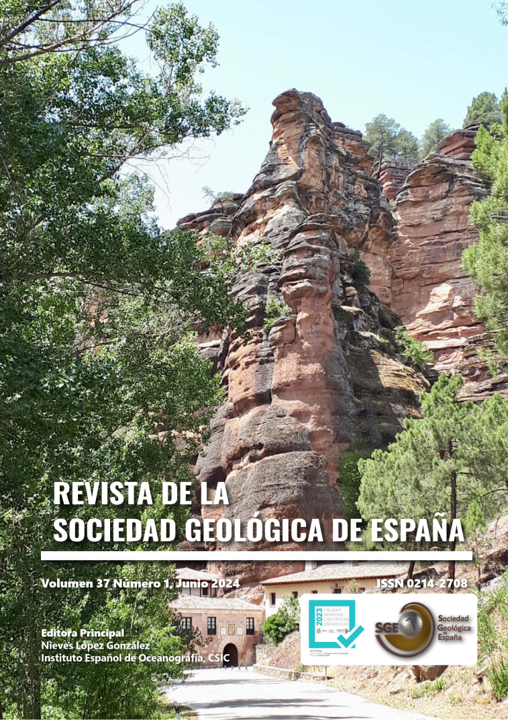Consideraciones históricas sobre el origen del concepto facies sedimentaria
DOI:
https://doi.org/10.55407/rsge.102162Palabras clave:
Facies sedimentaria, Amanz Gressly, macizo del Jura, historia de la geología, siglo XIXResumen
Se analiza tanto el origen como el significado del concepto de facies aplicado a las formaciones sedimentarias. Este término fue acuñado por el geólogo suizo Amanz Gressly en 1838 a partir de sus estudios en el macizo del Jura Oriental, al norte de los Alpes. Gressly tuvo en cuenta las dimensiones horizontales y verticales de los estratos, y junto con el contenido lítico también incluyó el componente paleontológico. De esta forma, se podían deducir las características ambientales del medio de sedimentación, y los factores tectónicos, que habrían condicionado su formación y, por otro lado, establecer las características paleogeográficas y paleoecológicas de una región, bajo los principios de la causalidad natural y del actualismo. Con anterioridad, durante los siglos XVII, XVIII y XIX, algunos autores habían señalado la importancia de considerar los restos fósiles para entender mejor las formaciones sedimentarias. En los primeros años, se estaban definiendo las principales unidades de la columna geológica y, al mismo tiempo, se estaba abandonando la corriente neptunista. La Geología necesitaba, pues, un nuevo marco teórico en el que desarrollar las nuevas investigaciones. Gressly, con su definición de facies, puso los cimientos de un nuevo sistema para entender el registro estratigráfico.
Citas
Cross, T.A., Homewood, P.W., 1997. Amanz Gressly's role in founding modern stratigraphy. Geological Society of America Bulletin, 109(12): 1617–1630. https://doi.org/10.1130/0016-7606(1997)109<1617:AGSRIF>2.3.CO;2
Feng, Z.Z., 2019. A review on the definitions of term of sedimentary facies. Journal of Palaeogeography, 8: 1-11. https://doi.org/10.1186/s42501-019-0045-3
García Cruz, C.M., 2018. “Aniversaries”: Facies, a geological concept (1838-2018) - 180 years ago. International Union of Geological Sciences E-Bulletin, No. 145, Item No. 4 (August 2018). [Reproducido en: INHIGEO Annual Record, 51: 76-77 (2019)].
Gressly, A., 1838. Observations géologiques sur le Jura soleurois [1ère partie]. Neue Denkschriften der Allgemeinen Schweizerischen Gesellschaft für die Gesammten Naturwissenschaften, 2: 1-112.
Gressly, A., [1838-1841]. Observations géologiques sur le Jura soleurois (1ère-4éme parties). Neuchâtel, Société Helvétique des Sciences Naturelles, Nouveaux mémoires, Nº 2, 349 p.+14 láminas [La primera parte se publicó también de forma independiente (referencia anterior)].
Hartmann, A., 1868. Amanz Gressly. En: Galerie berühmter Schweizer der Neuzeit. F. Hasler Lithograph, Baden im Aargau, vol. 1, Nº 36, p. [215-220].
Johnson, M.E., 2002. Amanz Gressly and the concept of facies. En: Discovering the Geology of Baja California. University Arizona Press, Tucson (AZ), 54-58. https://doi.org/10.2307/j.ctv1t4m2dk
Ledermann, H., 1965. Die wissenschaftliche Bedeutung von Amanz Gressly. Jurablätter, 27: 70-72.
Maillet, B. de, 1748. Telliamed, ou entretiens d’un philosophe indien avec un missionnaire françois. Che L’Honoré & Fils, Amsterdam, tomo 1, LIX+208 p.
Markovich, V.V., 1960. The concept of facies. International Geology Review, 2 (part 1, Introduction): 376-379. https://doi.org/10.1080/00206816009473574
Meyer, K., 1966. Amanz Gressly, ein Solothurner Geologue (1814-1865). Mitteilungen der Naturforschenden Gesselschaft in Solothurn, 22: 1-79.
Moore, R.C., 1949. Meaning of facies. Geological Society of America, Memoir 39: 1-34. https://doi.org/10.1130/MEM39-p1
Nelson, C., 1985. Facies in stratigraphy: from “terrains” to “terranes”. Journal of Geological Education, 33: 175-187. https://doi.org/10.5408/0022-1368-33.3.175
Prévost, C., 1839. Sol, roche, dépôt, formation et terrain. Bulletin de la Société Géologique de France, série 1(10): 340–345 (séance du 3 Juin).
Prévost, C., 1845. Sur la chronologie des terrains et le synchronisme des formations. Bulletin de la Société Géologique de France, série 2(2): 366–373 (séance du 7 Avril).
Rat, P., 1978. Sur le concept de faciès en géologie sédimentaire: faciès et environnements. En: Documents des Laboratoires de Géologie de la Faculté des Sciences de Lyon. Hors série n° 4, Les sédiments, leur histoire, leur environnement et leur devenir (Livre jubilaire Jacques Flandrin): 393-405. https://www.persee.fr/doc/geoly_0245-9817_1978_hos_4_1_1481
Rudwick, M.J.S., 2008. Worlds before Adam. The reconstruction of Geohistory in the Age of Reform. The Chicago University Press, Chicago (IL), XXII+648 p. https://doi.org/10.7208/chicago/9780226731308.001.0001
Schaer, J.-P., 1994. Géologues et géologie en pays neuchâtelois dans la seconde moitié du XIXe siècle. En: Histoire de l’Université de Neuchâtel (G. Attinger, Ed.). Université de Neuchâtel et Éditions, Neuchâtel, vol. 2: 397–403.
Schneer, C.J., 1981. Gressly, Amanz. En: Dictionary of Scientific Biography. (C.C. Gillispie, Ed.). Charles Scribner’s Sons, New York (NY), vol. 5: 533-534.
Smith, W., 1816. Strata identified by organized fossils. W. Arding, London, 24 p.+13 láminas.
Smith, W., 1817. Stratigraphical system of organized fossils. E. Williams, London, XI+121 p. https://doi.org/10.1017/CBO9780511702167
Stampfli, H.R., 1986. Amanz Gressly, 1814-1865: Lebensbild eines außerordentlichen Menschen. Mitteilungen der Naturforschenden Gesellschaft des Kantons Solothurn, 32: 7-160 [reed. 1993, con adiciones y correcciones].
Steno, N., 1669. De solido intra solidum naturaliter contento dissertationis prodromus. Florentiæ, Lythographia sub signo Stellæ, 78 p. [ed. bilingüe latín-inglés: Steno Geological Papers. (G. Scherz, Ed.). Odense University Press, Odense, 133-234 (1969)]. https://doi.org/10.5962/bhl.title.148841
Teichert, C., 1958. Concepts of facies. Bulletin of American Association of Petroleum Geologists, 42(11): 2718-2744. https://doi.org/10.1306/0BDA5C0C-16BD-11D7-8645000102C1865D
Tikhomirov, V.V., 1968. Development of geological sciences during the first half of the Nineteenth Century. Proceedings of the International Geological Congress (Prague, Czechoslovakia, 7-19 August), Report of the Twenty-third session, Section 13: 319-329.
Young, G., Bird, J., 1822. A geological survey of the Yorkshire coast. Georg Clark, Whitby, 332 p.
Walther, J., 1894. Einleitung in die Geologie als historische Wissenschaft. Gustav Fischer, Jena, tomos 2 y 3, 1.055 y 1.052 p.
Wegmann, E., 1962-1963. L’exposé original de la notion de faciès par A. Gressly (1814-1865). Sciences de la Terre, 9(1): 83-119.
Welland, M., 2009. Sand: The never-ending story. University of California Press, Berkeley (CA), 360 p. https://doi.org/10.1525/9780520942004
Woodward, J., 1695. An essay toward a natural history of the earth. R. Wilkin, London, [12]+277 p. https://doi.org/10.1017/CBO9781139696494
Zittel, K.A. von, 1899. Geschichte der Geologie und Paläontologie bis Ende des 19. Jahr-hunderts. R. Oldenbourg, München-Leipzig, XI+868 p. https://doi.org/10.1515/9783486731040
Descargas
Publicado
Cómo citar
Número
Sección
Licencia
Derechos de autor 2024 Cándido Manuel García Cruz

Esta obra está bajo una licencia internacional Creative Commons Atribución-NoComercial-CompartirIgual 4.0.

El/La Autor/a conserva los derechos de autor y concede a la Sociedad Geológica de España el derecho de la primera publicación y concede de manera no exclusiva los derechos de distribución de este artículo por la duración de la propiedad literaria según las leyes españolas, en todos los soportes actuales o futuros, estando la obra disponible simultáneamente a su publicación bajo la licencia Creative Commons CC BY-NC-SA 4.0, que permite copiar y transformar el trabajo, pero teniendo en cuenta que la distribución del trabajo transformado debe hacerse bajo la misma licencia y nunca con propósitos comerciales, al tiempo que se reconoce la autoría y la publicación original en la Revista de la Sociedad Geológica de España.










